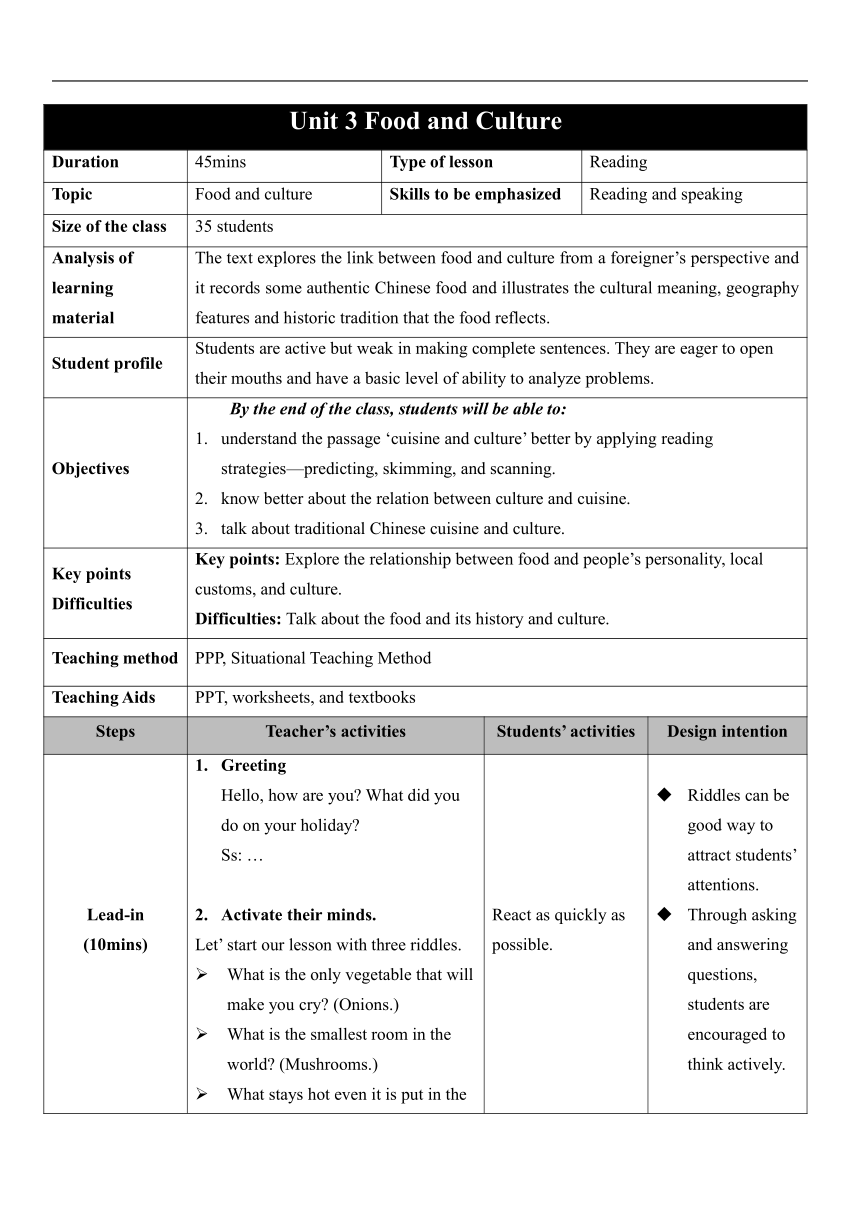人教版(2019)选择性必修第二册Unit 3 Food and Culture Reading and Thinking 教学设计(表格式)
文档属性
| 名称 | 人教版(2019)选择性必修第二册Unit 3 Food and Culture Reading and Thinking 教学设计(表格式) |  | |
| 格式 | docx | ||
| 文件大小 | 59.9KB | ||
| 资源类型 | 教案 | ||
| 版本资源 | 人教版(2019) | ||
| 科目 | 英语 | ||
| 更新时间 | 2024-01-02 13:49:05 | ||
图片预览


文档简介
Unit 3 Food and Culture
Duration 45mins Type of lesson Reading
Topic Food and culture Skills to be emphasized Reading and speaking
Size of the class 35 students
Analysis of learning material The text explores the link between food and culture from a foreigner’s perspective and it records some authentic Chinese food and illustrates the cultural meaning, geography features and historic tradition that the food reflects.
Student profile Students are active but weak in making complete sentences. They are eager to open their mouths and have a basic level of ability to analyze problems.
Objectives By the end of the class, students will be able to: understand the passage ‘cuisine and culture’ better by applying reading strategies—predicting, skimming, and scanning. know better about the relation between culture and cuisine. talk about traditional Chinese cuisine and culture.
Key points Difficulties Key points: Explore the relationship between food and people’s personality, local customs, and culture. Difficulties: Talk about the food and its history and culture.
Teaching method PPP, Situational Teaching Method
Teaching Aids PPT, worksheets, and textbooks
Steps Teacher’s activities Students’ activities Design intention
Lead-in (10mins) Greeting Hello, how are you What did you do on your holiday Ss: … Activate their minds. Let’ start our lesson with three riddles. What is the only vegetable that will make you cry (Onions.) What is the smallest room in the world (Mushrooms.) What stays hot even it is put in the fridge (Peppers.) 3. Guessing game Sichuan hotpot, lamb kebab, water-boiled dumplings, pancake rolls with green onions React as quickly as possible. Riddles can be good way to attract students’ attentions. Through asking and answering questions, students are encouraged to think actively.
While-reading (20mins) 4. Do you agree with “you are what you eat” Students read the first paragraph and share their views towards the opinion. Different ideas, but author provided his idea in the text. While reading, analyze the phrase “Chinese cuisine is a case in point.” 5. Prediction Based on the point, in the following paragraphs, what might be discussed to clarify the author’s opinion Questions from students: How many places are mentioned in the text What kind of food do they eat What is the connection between people and food 6. Genre and development of the text This passage develops through time. It is expository. 7. Answer questions after reading Work in groups and answer the questions on board with presenting power point at the same time. 8. Mind map Make a conclusion with a mind map. Food and culture go hand in hand. Students predict and skim the passage and add more information for discussing. Group discussion about the questions given and share in public. Before reading, the teacher hopes to provide a more general picture for students. English learning is more than its grammar or sentences from textbooks but is a bigger and more interesting world connected with their lives. Reading skills like scanning and skimming are practiced at this phase. Making a mind map can help them comprehend the structure well.
Post-reading (14mins) Introduce a local food in Xi’an to your foreign friend with clues. Discuss in their groups and present in public. Discussions make them digest and consolidate the things they learn in this class.
Homework (1mins) Finish the extended reading and read down your ideas on within 100 words.
Blackboard design Book 5 Unit 3 Food and Culture Period 2 Reading and thinking
After-class Reflection
Advantages Can I make them better
Disadvantages Suggestions
Duration 45mins Type of lesson Reading
Topic Food and culture Skills to be emphasized Reading and speaking
Size of the class 35 students
Analysis of learning material The text explores the link between food and culture from a foreigner’s perspective and it records some authentic Chinese food and illustrates the cultural meaning, geography features and historic tradition that the food reflects.
Student profile Students are active but weak in making complete sentences. They are eager to open their mouths and have a basic level of ability to analyze problems.
Objectives By the end of the class, students will be able to: understand the passage ‘cuisine and culture’ better by applying reading strategies—predicting, skimming, and scanning. know better about the relation between culture and cuisine. talk about traditional Chinese cuisine and culture.
Key points Difficulties Key points: Explore the relationship between food and people’s personality, local customs, and culture. Difficulties: Talk about the food and its history and culture.
Teaching method PPP, Situational Teaching Method
Teaching Aids PPT, worksheets, and textbooks
Steps Teacher’s activities Students’ activities Design intention
Lead-in (10mins) Greeting Hello, how are you What did you do on your holiday Ss: … Activate their minds. Let’ start our lesson with three riddles. What is the only vegetable that will make you cry (Onions.) What is the smallest room in the world (Mushrooms.) What stays hot even it is put in the fridge (Peppers.) 3. Guessing game Sichuan hotpot, lamb kebab, water-boiled dumplings, pancake rolls with green onions React as quickly as possible. Riddles can be good way to attract students’ attentions. Through asking and answering questions, students are encouraged to think actively.
While-reading (20mins) 4. Do you agree with “you are what you eat” Students read the first paragraph and share their views towards the opinion. Different ideas, but author provided his idea in the text. While reading, analyze the phrase “Chinese cuisine is a case in point.” 5. Prediction Based on the point, in the following paragraphs, what might be discussed to clarify the author’s opinion Questions from students: How many places are mentioned in the text What kind of food do they eat What is the connection between people and food 6. Genre and development of the text This passage develops through time. It is expository. 7. Answer questions after reading Work in groups and answer the questions on board with presenting power point at the same time. 8. Mind map Make a conclusion with a mind map. Food and culture go hand in hand. Students predict and skim the passage and add more information for discussing. Group discussion about the questions given and share in public. Before reading, the teacher hopes to provide a more general picture for students. English learning is more than its grammar or sentences from textbooks but is a bigger and more interesting world connected with their lives. Reading skills like scanning and skimming are practiced at this phase. Making a mind map can help them comprehend the structure well.
Post-reading (14mins) Introduce a local food in Xi’an to your foreign friend with clues. Discuss in their groups and present in public. Discussions make them digest and consolidate the things they learn in this class.
Homework (1mins) Finish the extended reading and read down your ideas on within 100 words.
Blackboard design Book 5 Unit 3 Food and Culture Period 2 Reading and thinking
After-class Reflection
Advantages Can I make them better
Disadvantages Suggestions
